#Gambrinus Restaurant Naples
Text
Going to Naples and Sorrento - on an Italian opera trail.
Watching Mount Vesuvius from Sorrento, across the Bay of Naples, I thought of Pliny the Younger (born 61 AD), as you do, who wrote a detailed description of the catastrophic eruption of the volcano (79 AD) that killed his uncle, the great Roman naturalist, Pliny the Elder, who sailed into the disaster because he was interested in the science of volcanoes. Pliny the younger watched the destruction…

View On WordPress
#Anja Kampe#caruso#Caruso cocktail#caruso restaurant#Enrico Caruso#Farinelli#Fidelio#Fidelios prisoners&039;. chorus#Galleria Umberto I Naples#Gambrinus Restaurant Naples#Gerusalemme liberata by Tasso#Giovanni Battista Rubini#Handel&039;s Lascia ch&039;io pianga#Handel&039;s Rinaldo#Italian holidays#Italy#Joyce DiDonato#naples#opera#Peter Sieffert#San Carlo Opera House#Sonia Bergamasco#sorrento#Surriento#tasso#tenors#torna a surriento#Torquato Tasso#Zubin Mehta
0 notes
Photo

THE WORLD IS MINE TO EXPLORE . l love cooking and eating. Anywhere I go I make sure to try delicacies from places that are popular amongst the locals. Whilst I tried a lot of things in a week, here are 10 of my most favourite things : Pic 1 - Sfogliatelle - It’s a flaky puff pastry with a delicious cremey filling made of ricotta and candied lemons. There are two kinds soft and crispy - I like the crispy ones. Pic 2 - Selections of pastries from the Gambrinus cafe, I tried around 9 different kinds and all of them were good but the Tiramisu, lemon granita, orange sorbet and the raspberry tart was to die for. Pic 3 - Coffee from the Gambrinus cafe, again they have loads of variety, I tried 6 different kinds and the espresso is my favourite! Pic 4 - You cannot not have pizza when in Napels, the best pizza I have had was from a place called Sorbillo. Pic 5, 6 and 7 - There is a place called Trattoria Da Nenneta which serves a 4 course meal for only 12 euros and the food was brilliant. The atmosphere was great too, check my stories. I tried the most delicious spaghetti with fresh tomatoes and olive oil, roasted zucchini with olive oil and mint and Rum Baba (an Italian sponge soaked in Rum, it's delicious) Pic 8 and 9 - Another restaurant that you must try is Tandem, check my story. They served Friarelli - It is a bitter green from Campania that can be served as a contorno or side dish and the Caprese Salad was to die for too! Pic 10 - Cafe Centro - There is a cafe called Cafe Cento and their shaked coffee is a must have! In addition to all of the above I tried lots of other dishes including wonderfully juicy watermelons, gelatos, difens kinds of pasta and gallons of wine. I could write a book about how good the food was. . #designerayushkejriwal #ayushkejriwal #napels #foodlover #traveldiaries (at Naples, Italy) https://www.instagram.com/p/CD60u_bJIKx/?igshid=j8kb99d6ulqv
0 notes
Photo
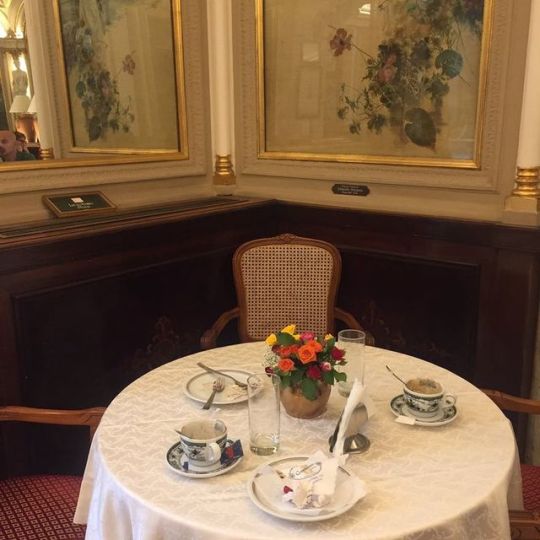
GRAN CAFFE GAMBRINUS, Naples – San Ferdinando – Updated 2019 Restaurant Reviews,… https://ift.tt/2LhYV4e
0 notes
Text
Gran Caffe Gambrinus, Naples, Italy, 12/20/19
exterior
Gran Caffe Gambrinus is a huge ornate place that is mostly a coffee and pastry restaurant. They do serve heavier food but most people seemed to be enjoying a pastry, coffee and the surroundings. The place has been around for 150 years and was restored in 1890 when they brought in many of the paintings and statues. It has been visited by many celebrities over the years, like Ernest…
View On WordPress
0 notes
Text
Benvenuti al sud - Episode 3
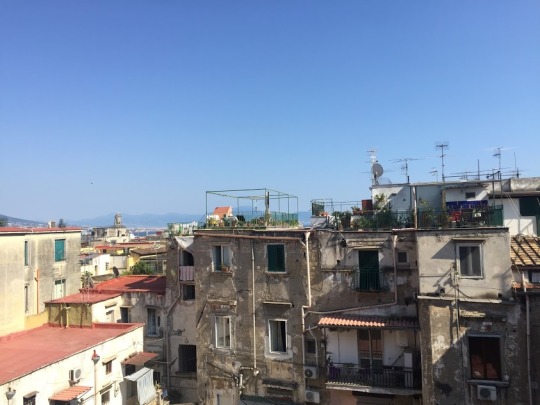
Vedi Napoli e muori
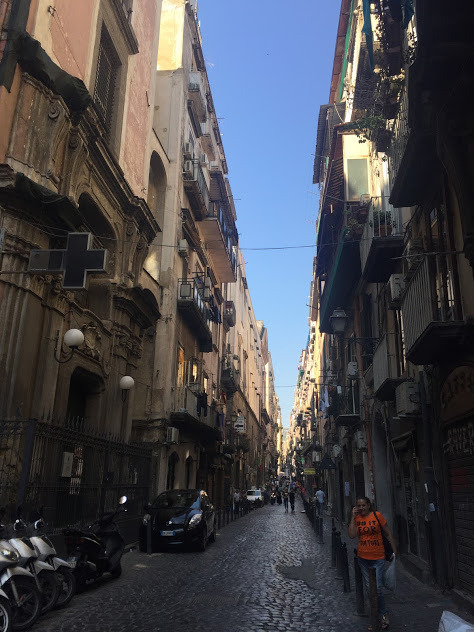
Le dimanche nous décidons de laisser la voiture à la station de Scafati et de prendre le train régional pour aller à Naples. Les trains sont nouveaux et modernes, un peu en retard (presque toujours) et pas chers (2,80€ pour un trajet de un peu plus d’une heure). Le trafic des jours avant nous avait convaincu de ne pas nous aventurer en voiture à Naples!
Passant par les rues principales du centre historique nous arrivons à la place Treviso et Trieste, où je goûta une sfogliatella chez le fameux café Gambrinus. Elle fût délicieuse: la pâte feuilleté croustillante, la farce encore un peu chaude, avec des notes d’orange, cannelle et semoule cuite au lait. Nous continuons vers le château dell’Ovo, qui fuit restructuré la dernière fois sous le règne des Aragonais. Ils furent très actifs dans cette région! L’entrée est libre et on a des merveilleuses vues sur la baie de Naples.
Le midi nous mangeons une vraie pizza napolitaine. Elle était ÉNORME. Exténués et légèrement bourrés nous n’avaient pas envie de passer tout l’après-midi au soleil, donc on décida de faire une visite guide dans la Napoli Sotterranea. Sous l’église de San Lorenzo Maggiore se trouve une ancienne rue commerciale romaine, qui existait déjà en temps grecs et fut utilisé aussi en temps médiévales. C’est incroyable, une ville sous la ville! Dans le musée de l’église on peut voir les objets y rencontrés, témoins des vastes relations économiques qui existaient il y a presque 2500 ans. Il y a plusieurs offreurs pour des visites de Naples souterraine, nous payions 7€ avec la carte étudiant et il parait que les autres coûtent à peu près le même.
La rentrée le soir fut magique, car les voies du train passent à côté de la mer, et le soleil était en train de disparaître et on voyait Ischia dans le lointain…

Am Sonntag entschlossen wir uns, das Auto am Bahnhof in Scafati stehen zu lassen und mit der S-Bahn nach Neapel zu fahren. Die Züge sind neu und sehr modern, ein bisschen verspätet (fast immer) und ziemlich günstig (2,80€ für etwas mehr als eine Stunde Fahrt). Der Verkehr der vorherigen Tage hatte uns ziemlich überzeugt uns nicht mitm Auto nach Neapel zu wagen!
Über die wichtigsten Hauptstraßen der Altstadt gelangten wir zur Piazza Treviso e Trieste, wo ich eine Sfogliatella im berühmten Café Gambrinus aß. Sie war herrlich: Der Blätterteig knusprig, die Füllung noch ein bisschen warm, mit leichter Orangen-, Zimt- und Grießnote.
Wir gingen weiter zum Castel dell’Ovo, das zuletzt unter den Aragonesern restrukturiert wurde (sie waren sehr aktiv in dieser Gegend). Der Eintritt ist frei und man hat einen wunderbaren Ausblick auf die Bucht von Neapel.
Zu Mittag aßen wir in einer traditionsreichen neapolitanischen Pizzeria. Die Pizzen waren dermaßen riesig dass wir sie fast nicht aufessen konnten! Müde und leicht betrunken hatten wir wenig Lust den ganzen Nachmittag in der prallen Sonne zu sitzen, also beschlossen wir, Napoli sotterranea einen Besuch abzustatten. Unter der Kirche von San Lorenzo Maggiore befindet sich eine alte römische Einkaufsstraße, die bereits zu Zeiten der Griechen existierte und auch noch später im Mittelalter besucht wurde. Eine Stadt unter der Stadt! Im Museum der Kirche kann man die dort gefundenen Objekte besichtigen, Zeugen der weitgestreuten wirtschaftlichen Beziehungen die es bereits zu römischen Zeiten gab. Es gibt mehrere Anbieter für unterirdische Touren, wir zahlten 7€ pro Person (mit Studentenausweis) und soweit ich weiß kostet es überall ungefähr gleich viel, man sieht halt andere Teile der Ruinen.
Die Rückfahrt am Abend war sehr romantisch, da die S-Bahn ziemlich nah am Wasser fährt und die Sonne gerade unterging und man Ischia in der Ferne sah…
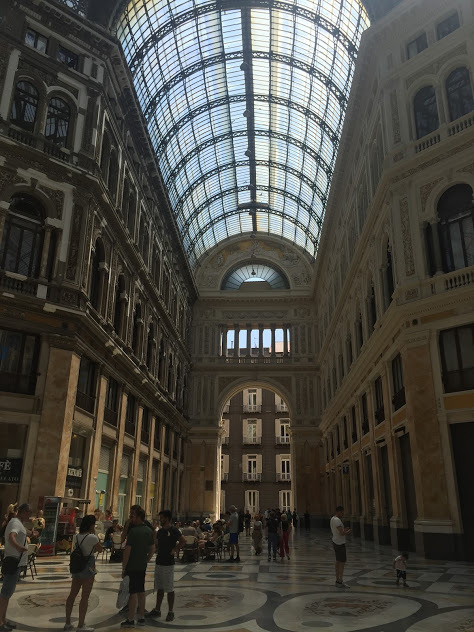
El domingo decidimos dejar el coche en la estación de Scafati y coger el cercanías hacía Naples. Los trenes son nuevos y modernos, un poco impuntuales (casi siempre) y baratos (2,80€ para un poco más de una hora de trayecto). El tráfico de los días anteriores nos había convencido de no aventurarnos en coche por Naples!
Visitamos las calles principales del casco antiguo y bajamos hasta la plaza Treviso e Trieste donde cogí una sfogliatella en el famoso café Gambrinus. Era deliciosa: el hojaldre crujiente, el relleno aún un poco caliente, con delicadas notas de naranja, canela y sémola cocida con leche.
Continuamos hacía el Castel dell’Ovo, reestructurado la última vez bajo los aragoneses (que fueron muy activos en esta zona). Se puede visitar gratuitamente y ofrece unas vistas bonitas sobre las bahías de la ciudad.
A mediodía, comimos en una verdadera pizzería napoletana. ¡Casi casi no conseguimos terminar las pizzas! Eran realmente enormes. Cansados y ligeramente borrachos, no teníamos muchas ganas de pasar toda la tarde al sol, decidimos hacer una visita guiada en “Napoli sotterranea”, un itinerario realmente impresionante. Bajo la iglesia de San Lorenzo Maggiore se puede visitar una antigua calle mercantil, donde son visibles aún los inicios griegos de la ciudad, las aportaciones romanas y la continuación medieval. ¡Una ciudad bajo la ciudad! En el museo de la iglesia se pueden ver los objetos allí encontrados, testigos de las extensas relaciones comerciales que había ya en tiempo romanos. Hay varios sitios que proponen una visita de Napoli sotterranea, nosotros pagamos 7€ (descuento estudiantes) y parece que el precio es parecido, lo único que cambia es el monumento que se visita.
La vuelta por la noche fue preciosa, ya que las vías del cercanías pasan cerca del mar - el sol estaba bajando y se veía Ischia en la bruma…
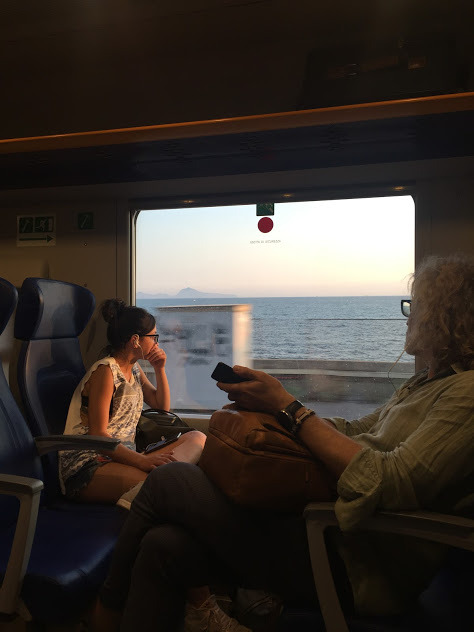
From Cetara to Erchie
Pendant notre première visite on avait reçu une carte assez détaillé d’une partie de la peninsule amalfitaine, avec des randonnées intéressantes. Le plan était de marcher de Cetara à Erchie et, si les conditions le permettaient, monter sur une cime avant. Bon, je ne sais pas où exactement on a fait une mauvaise tournée, mais on se trouva au milieu du rien, sans aucune signalisation, avec une seule bouteille d’eau, à douze heures du matin. C’est dificile de se perdre complètement, car on voit toujours la mer, mais on décida quand même de faire demi-tour et de passer l’après-midi à la plage. Erchie est un village sans accès pour voitures, donc il n’y a pas de touristes, mais plein d’Italiens. La plage est remplie de chaise longues, donc on a du s’assoir sur le trottoir.

Während unseres erstens Besuches hatten wir eine ziemlich detaillierte Karte eines Teiles der amalfitanischen Halbinsel bekommen, mit einigen interessanten Wanderungen. Der Plan war von Cetara bis nach Erchie zu wandern, und, wenn es die Bedingungen zuließen, zuerst noch auf einen Gipfel zu steigen. Gut, wir haben keine Ahnung wo wir falsch abbogen, aber irgendwann fanden wir uns mitten im Nirgendwo, mit keiner einzigen Wegmarkierung, um zwölf Uhr Mittags und nur noch einer vollen Wasserflasche. Es ist ziemlich schwer sich vollends zu verlaufen, da man ja immer das Meer sieht, aber wir beschlossen trotzdem umzudrehen und in Erchie am Strand zu relaxen. Erchie ist ein Dorf ohne Autozufahrt, weswegen hier kaum ausländische Touristen sind, dafür umso mehr Italiener. Der Strand ist vollgestellt mit Liegestühlen, wir mussten also am Gehsteig Platz nehmen.

Durante nuestra primera visita habíamos recibido un mapa bastante detallado de una parte de la península de Amalfi, con varios itinerarios marcados que parecían muy interesantes. Nos planteamos de llegar desde el pueblo de Cetara hasta Erchie, y, si las condiciones lo permitían, subir antes hasta uno de los picos. Bueno, no se donde cogimos el mal camino, pero nos encontramos en el medio de la nada, con absolutamente ningún camino marcado, a las doce del mediodía y con solo una botella de agua llena. Es difícil perderse por completo, ya que siempre se ve donde está el mar, pero dimos la vuelta y decidimos de parar y descansar en Erchie. Es un pueblo que no tiene acceso para coches, así que no hay casi turistas extranjeros, pero sí que italianos. La playa estaba a tope, tuvimos que quedarnos en la acera casi.

Birthplace of Pasta and Punta Campanella
Notre logement se trouvait pas loin de Gragnano, lieu de naissance de la pasta comme on la connaît aujourd’hui. Le village se trouve à l’entrée d’une vallée, où la force de l’eau fut utilisé depuis très tôt pour alimenter des moulins. Aujourd’hui il reste qu’un seul moulin (plus ou moins) conservé qu’on peut visiter (plus ou moins). Il restent quand même pleins de pastificios avec une bonne réputation, et c’est vrai que la qualité de leur pâtes surpasse de loin celle des produits normaux. On controllá ca quelques instants plus tard dans un restaurant à Castello di Lettere. On nous servit des Paccheri sauce tomate et salsiccia porcini, les deux plats merveilleux.
Après une délicieuse sieste sur la place principale du village on décida d’aller à Sorrente. On passant la ville on vit que des hôtels, donc on décida de continuer sur la route. Après un bain rafraîchissant à Termini on continua vers la Punta Campanella, où les grecs avaient déjà construit un phare et un temple dédié à Athène. Le chemin est bien entretenu et en partie consiste encore des anciennes pierres posées par les romains. C’est la pointe la plus proche à l’Île de Capri, et vu que le ferry est que pour les riches… on profita.
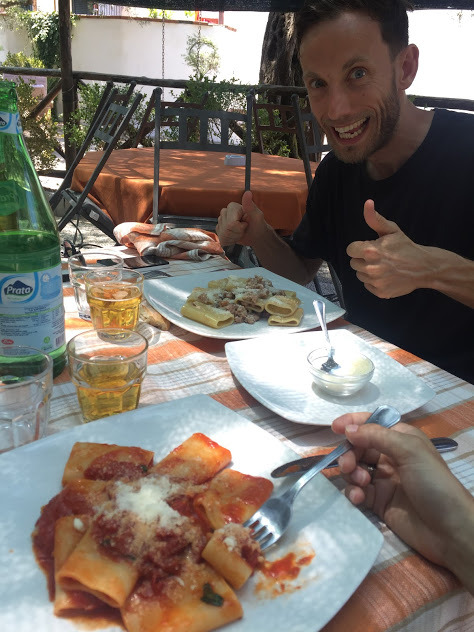
Unsere Unterkunft befand sich in der Nähe von Gragnano, Geburtsort der Pasta wie man sie heute kennt. Das Dorf liegt am Eingang eines Tals wo schon früh die Kraft des Wassers für Mühlen verwendet wurde. Heute steht nur noch eine dieser Mühlen (mehr oder weniger) und man kann sie besichtigen (mehr oder weniger). In Gragnano gibt es aber weiterhin einige pastificios mit hervorragendem Ruf, und es ist wahr dass die Qualität ihrer Nudeln weit über die der herkömmlichen Marken hinausgeht. Wir untersuchten diese Behauptung aufs genaueste ein paar Minuten später in einem Restaurant in Castello di Lettere, wo man uns Paccheri mit einmal Tomatensoße und einmal Salsiccia e Porcini servierte.
Am Nachmittag, nach einer ausführlichen Siesta auf dem Kirchplatz in Castello, fuhren wir nach Sorrento. Beim Durchfahren sahen wir nur ein Hotel ans nächste gereiht, weswegen es auch nur beim Durchfahren blieb und wir stattdessen das Auto in Termini stehen ließen. Nach einem erfrischenden Bad in dieser wunderschönen Bucht gingen wir weiter bis zur Punta Campanella, wo bereits die Griechen einen Leuchtturm gebaut hatten und einen Tempel Athena in Ehren errichtet hatten. Der Weg ist sehr gut in Stand gehalten und ein gutes Stück davon ist noch mit dem Originalsteinen aus römischen Zeiten erhalten. So nah wie auf dieser Spitze kommt man Capri übrigens sonst nur mit dem Boot, was wir uns nicht leisten konnten - das heben wir uns für den nächsten Lottogewinn auf.
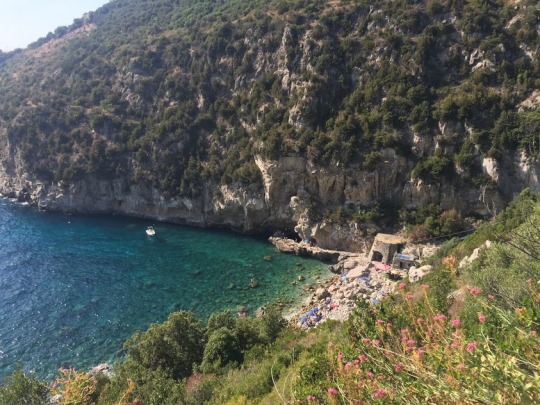
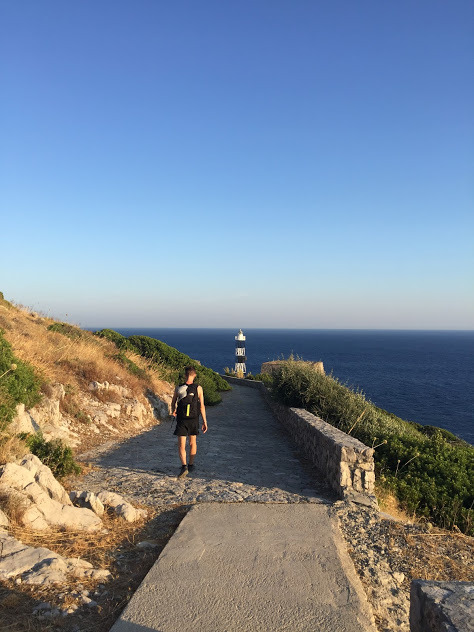
Nuestro alojamiento no se encontraba lejos del pueblo de Gragnano, sitio de nacimiento de la pasta tal y como se conoce hoy. Se encuentra a la desembocadura de un val y antiguamente había un montón de molinos alimentados por el río que salía del val. Hoy en día solo queda un molino medianamente bien restaurado, que se puede visitar (más o menos). Quedan en Gragnano unos cuantos pastificios con buenísima reputación, y es verdad que la calidad de su pasta no es comparable con la normal y corriente. Lo comprobamos unos instantes después en un restaurante en Castello di Lettere, donde nos sirvieron unos “paccheri” con salsa de tomate recién cogido de la huerta y salsa de salchicha con hongos.
Por la tarde, después de una buena siesta en la plaza principal de Castello, decidimos irnos por la zona de Sorrento. Pasamos por el pueblo y flipamos a ver tantos hoteles, autobuses, hoteles y hoteles. ¿¿Dónde estaba el pueblo?? Así que nos fuimos hasta Termini, donde bajamos hasta una cala para tomar un baño refrescante antes de irnos hasta Punta Campanella, donde ya los griegos habían montado un faro y un templo consagrado a la diosa Atenea. El camino está muy cuidado y en algunas partes aún se conservan las piedras que pusieron los romanos. Es también la punta más cercana a Capri, así que la pudimos ver de muy cerca (el ferry sale a más de 20€ solo ida… es para cuando gane la lotería).

Saying goodbye
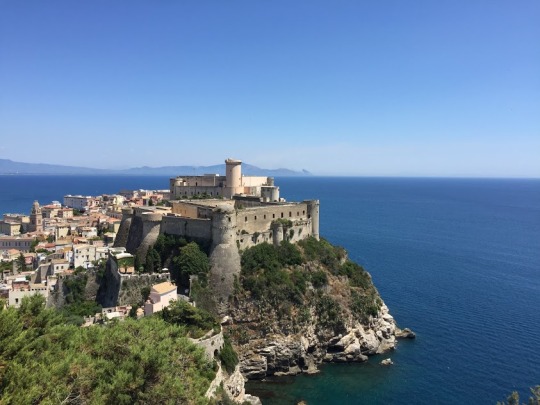
Les derniers jours on les passa proche de Formia, pas loin de Rome. On vit Gaeta et son château aragonais, mais que de dehors, car c’est une école de police aujourd’hui. On remplit la voiture de nourriture italienne (90% pâtes) et goûta les derniers couchers de soleil italiens…
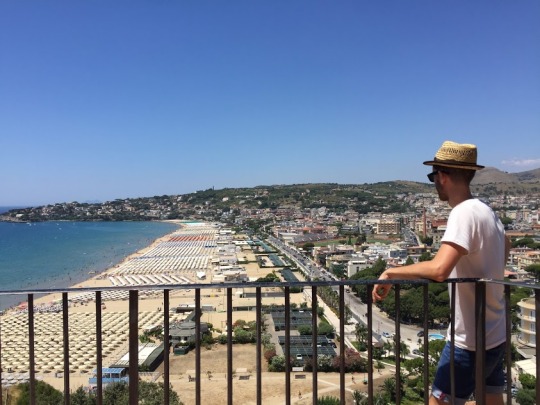
Die letzten Tage verbrachten wir in der Nähe von Formia, nicht weit von Rom. Wir sahen Gaeta und ihr aragonesisches Schloss, aber nur von draußen weil es heute eine Polizeischule beherbergt. Wir füllten das Auto mit italienischem Essen (also 90% Nudeln) und genossen die letzten italienischen Sonnenuntergänge…
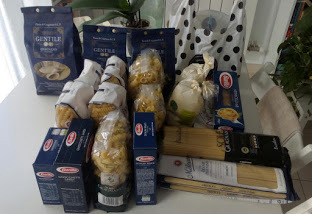
Los últimos días los pasamos en la zona de Formia, cerca de Roma. Vimos Gaeta y su castillo aragonés, pero solo por fuera, ya que hoy en día es la Escuela de la Guardia di Finanza. Llenamos el coche de comida italiana (osea 90% pasta) y disfrutamos del último atardecer italiano…
0 notes
Text
36 Hours in Naples, Italy
A city of glorious but tattered beauty, known for its vibrancy and, yes, a frisson of menace, Naples is now humming with visitors. In this Mediterranean capital watched over by the still-kicking Vesuvius volcano, tourist numbers have more than doubled since 2010, crime has dropped (notably, the murder rate is down 44 percent in 2018 over the previous year, according to the Ministry of the Interior), and the intransigent piles of trash are far fewer. Elena Ferrante’s beloved Neapolitan Novels (and the ongoing HBO adaptation of them) — along with the gritty “Gomorrah” books, movie and TV series — has roused curiosity about a destination long considered little more than a steppingstone to Capri, Ischia and Amalfi. And while the Museo Archeologico, with its extraordinary collection of antiquities, remains a bit neglected, most of the city’s art, culture and social scene are on an optimistic bender, and the charms of Naples — the Baroque excess, the indulgent cuisine, the mesmerizing fugue state of it all — beckon as they did in the city’s Grand Tour glory days.
Friday
1) 3 p.m. Dream home
Naples is a city of masquerades, of staged operas and tromp l’oeil pomp. Acquaint yourself with the pageantry at the Villa Pignatelli, a house museum built as a private mansion in 1826, which harks back to the end of Naples’ heyday during the Bourbon reign here, when the city was one of Europe’s most dazzling capitals. It’s not quite the Reggia di Caserta (the 1,000-plus room palace 18 miles outside Naples, built on the model of Versailles), but this neo-Classical jewel is a sumptuous introduction to the florid tastes of the city’s golden age, with its gilded chandeliers, frescoed Pompeii-style bathroom, intricate boiserie panels and spectacular English garden, all putting on the airs of earlier illustrious eras. Admission: 5 euros, or about $5.50.
2) 5 p.m. Chic boutiques
The Chiaia neighborhood offers a slew of Italian luxury brands, but also some distinctively local shops, like Livio De Simone, a fabric printer since the 1950s. The house’s nearby atelier silk-screens a line of dresses, bags and textiles whose bright, geometric patterns carry over to the store’s ceramics made in nearby Vietri. In this city renowned for sartorial men’s wear, custom-fitted suits and shirts may require time, but Naples’ artisan tie makers offer quicker gratification, as at Ulturale, where handmade, tailored neckwear is available in a rainbow of classic versions with good luck charms sewn inside. For an even more colorful adventure, stop into Dr. Vintage, where the owner, Rosario Recano, regales visitors with tips for his city while showing off his pristine secondhand designer collection. And jewelry lovers can tuck over to Leonardo Gaito on Via Toledo, a family-run shop that’s been around since 1864, where new works from local artisans complement antique creations.
3) 7 p.m. Aperitivo up high
On Via Toledo, the main street known as Spaccanapoli (“Naples splitter”), take the funicular to the upscale neighborhood of Vomero, a long sleepy enclave that’s home to a handful of spirited destinations. Start with Riot Laundry Bar, a concept store run by a young team, and a magnet for the reawakened music scene in Naples. Beyond the street wear and ecological jeans on offer, there’s an energetic ground-floor bar (beer, 5 euros) and Futuribile, a basement record shop with Italo disco, boogie and 1980s-era albums recorded in Naples. Opening at 8 p.m. up the block, Archivio Storico is improving the art of drinking in Naples with cocktails (around 10 euros) based on antique Neapolitan recipes as well as classic American styles, served in an underground network of intimate grotto rooms.
4) 9 p.m. Family dinner
Just behind the waterfront promenade, Casa di Ninetta serves what the owner, Carmelo Sastri, calls “my mother’s and my grandmother’s home-cooking” in this decade-old operation run with his sister, the well-known Italian singer and actor Lina Sastri. Under an ornate, late-19th-century ceiling, with classical music in the background, the restaurant prepares magnificent renditions of Neapolitan traditions, like bocconcini di baccalà (fried codfish balls; 10 euros), and the dense onion ragù of pasta Genovese (11 euros). Cleanse your palate with a basil amaro from nearby Capri (6 euros), and stroll along the seaside to appreciate the ancient block of Castel dell’Ovo illuminated on the water.
Saturday
5) 9 a.m. Breakfast bliss
Perhaps the least healthy but happiest way to start a day in Naples is with a sfogliatella, a pastry pocket of fresh ricotta with candied fruit and frolla (smooth) or riccia (ridged) shell, all made crumbly with lard. (Note to vegetarians and vegans in Naples: Expect lard where you would least expect it.) Scaturchio, making the same flawless recipes since 1905 in this Piazza San Domenico Maggiore location, serves an extraordinary sfogliatella riccia (1.70 euros) with a gossamer crust and a delicate orange-flecked cream.
6) 10 a.m. Contemporary city
Naples was a magnet for new art in the 1970s; after a long lull, the city’s art scene is buzzing again, epitomized by last year’s opening of an exhibition space by the London-based Thomas Dane gallery inside the 19th-century Villa Ruffo. Also in the Chiaia district, the Galleria Lia Rumma has presented the works of Anselm Kiefer, Mario Merz, Marina Abramovic, Alfredo Jaar and other groundbreaking artists here since 1971. Another pioneering gallerist of the 1970s, Giuseppe Morra, opened the Casa Morra in 2016 to exhibit his extensive personal collection inside a crumbling 18th-century palazzo.
7) 1 p.m. Lunch special
The family-run Trattoria San Ferdinando offers a cozy respite from Naples’ hectic streets. At this establishment, whose butter-yellow walls are hung with copper pots and antique musical scores, the menu changes daily “according to nature,” as the owners like to say. The excellent fish-focused offerings may include dishes (around 12 euros each) like bass carpaccio marinated with oranges and lemons, or zigoli pasta with zucchini flowers, mussels and a light basil pesto. Desserts, like the velvety ricotta cake with orange marmalade, are equally enchanting.
8) 2:30 p.m. Hushed havens
Naples’ religious sites are marvels of artistry. Steps from the Duomo, the often-overlooked Donnaregina convent complex encompasses the soaring naves of two churches — a 14th-century, intricately frescoed Gothic church, and an extravagantly gilded Baroque church in multicolored marble — as well as the Museo Diocesano, housing ecclesiastical artworks, mostly from the Naples school of painters, which includes the 17th-century painters Luca Giordano and Andrea Vaccaro. A few steps away, the 14th-century Santa Chiara cloister encircles a citrus garden ornamented with majolica-tiled columns and benches. Hand-painted by the ceramists Donato and Giuseppe Massa in the mid-1700s, the tiles, festooned with flowers, vegetables and storytelling scenes, were the exclusive delight of the nuns who lived there in seclusion for nearly 200 years, until monks took their place and opened the grounds to the public in 1925.
9) 5:30 p.m. Cafe culture
It’s a tenacious fight for the top coffee spot in Naples — the city is often said to serve the best espresso in Italy — where the local method produces a dense syrup of an espresso shot, often with a hefty dose of sugar already mixed in unless otherwise specified, and served alongside sparkling water to cleanse your palate beforehand. For an espresso in what is surely the most exquisite cafe in town, grab a red velvet cane chair in the gilt-edged rococo environs of Gambrinus (4 euros for a table-service espresso; 1.20 at the counter).
10) 7 p.m. Street life
For all its bygone splendor, Naples is a casual city, dominated by street food and cheap bars. For an authentic taste of it all, head to Via Tribunali, the principal thoroughfare for pizza, peppery Neapolitan taralli, and deep-fried everything. At the friggitoria (fried food stand) of Di Matteo, the cuoppo, or paper cone, of deep-fried items like potato fritters, polenta and eggplant is an unmissable Naples delicacy. Down the road, enjoy a pre-dinner drink at Perditempo, a scruffy, beloved local bar and an unpretentious literary cafe hosting occasional book readings, but more frequently blasting reggae music into the crowd gathered streetside.
11) 9 p.m. Downtown dinner
In a convivial dining room embellished with its original 1941 frescoes of Naples and portraits of bygone Italian celebrity regulars, Mimì alla Ferrovia serves dishes that have themselves barely changed over time, with an equally immutable and formally dressed staff. A dynasty of four family generations of owners and three in the kitchen put continuity at the heart of this restaurant in the central (and sketchy) train station neighborhood. Serving mostly locally caught Mediterranean fish, the chef, Salvatore Giugliano (grandson of the restaurant’s first chef), has tweaked the traditional recipes, excelling with bass ravioli with butter, broth, shrimp and squid (12 euros), and a ricotta of the region’s special buffalo milk topped with his housemade Vesuvian tomato jam (2 euros).
Sunday
12) 10 a.m. The Naples underground
To truly appreciate Naples, old and new, head into its subterranean belly. Since 1995, metro stations have been embellished with more than 200 public artworks; next year will see a new Duomo station by the architect Massimiliano Fuksas that pays homage to the Roman temple discovered amid the excavations. And at 130 feet below, wonders of the ancient world are revealed, as the Napoli Sotterranea organization’s tour (10 euros) takes you into a maze of caves that stretches over 280 miles, carved into the volcanic tuff bedrock by the Greeks in the 4th century B.C. The 90-minute tour guides visitors past a Greek-Roman theater where Nero once performed, and through the archaic hollows where Neapolitans took shelter during World War II air raids.
13) noon. Elevated art
A new shuttle service running from Piazza Trieste e Trento to the Museo Capodimonte (16 euros round trip, including museum entrance) makes this under-visited treasure trove more accessible. The gargantuan castle, begun in 1738, was constructed as a hunting lodge for the Bourbon king Charles III. Perched on a hilltop with views across the city to Capri and Ischia, Capodimonte is surrounded by the 300 acres of woods and parkland that originally served as royal hunting grounds. Inside, the staggering collection of art includes masterpieces by Titian, El Greco, Caravaggio and Raphael.
14) 2 p.m. Pizza party
No one comes to Naples to get skinny, and the pizza, invented here in the 19th century, is still probably better than anywhere else. At Concettina ai Tre Santi, the chef Ciro Oliva may be the most talented pizzaiolo in town, the fourth generation of a family dynasty running this folksy dining spot in the working-class Sanità neighborhood. For the very hungry, the chef proposes the hedonistic 12-course pizza-tasting menu (45 euros, call ahead), alongside single pies (8 euros) all made with local ingredients, and a well-researched wine list that includes a decadent Pertois-Moriset Champagne. Menu highlights include the Parthenope, a fried pizza stuffed with buffalo ricotta, smoked ricciola, seaweed, orange zest and ground pepper. No reservations, but it’s worth the wait.
Lodging
Airbnb offers affordable options throughout the city (average rate, $73), with plenty of stylishly modern apartments in the swankier Chiaia neighborhood.
The new wave of tourism has produced an elegant crop of small-scale modern hotels, like the eight-room Artemisia Domus (from 119 euros a night), which opened inside a former fourth-floor residence in 2018, rebuilt with wood beams, the remains of a fresco, and a few other original details intact. Some stairs are involved, but the hotel rewards you with spacious rooms, some with a sauna or Jacuzzi.
Located in Naples’ pretty, seaside Posillipo neighborhood, Primo Piano Posillipo (from 105 euros a night) — conceived by the architect Giuliano Andrea dell’Uva, and opened in February — is a colorful vision of contemporary style, showcased in its four airy rooms, including one with a stunning Mediterranean view.
For traditional grandeur, the 137-year-old, nine-story Grand Hotel Vesuvio (rooms with seaview balconies, from 290 euros), on Naples’ pedestrian waterfront, overlooks the Castel dell’Ovo and the Bay of Naples. Its upholstered walls, Murano chandeliers and liveried staff suggest the old-school sophistication of another age.
52 PLACES AND MUCH, MUCH MORE Follow our 52 Places traveler, Sebastian Modak, on Instagram as he travels the world, and discover more Travel coverage by following us on Twitter and Facebook. And sign up for our Travel Dispatch newsletter: Each week you’ll receive tips on traveling smarter, stories on hot destinations and access to photos from all over the world.
Sahred From Source link Travel
from WordPress http://bit.ly/2G8iMRM
via IFTTT
0 notes
Text
Tired of your hectic busy schedule, the Indian summer heat, city traffic and the unending chatter in your mind?
Go to Europe. Travel to the coastal idyllic villages of Cinque Terre, enjoy the Mediterranean landscape of Amalfi (Sorrento + Positano) or gaze at the horizon from the Mt Solaro in the island of Capri, walk on the streets of the historic ruins of Pompeii, nibble the famous Neapolitan pizza (at Naples)or indulge in luxury shopping in Milan and Bellagio (Lake Como). If you have INR 0.25-0.3 million you can experience all these in 8 days, which means you need to take leave from your office for only 5 working days.
I took my flight for Milan on a Friday night (23rd Sep) and returned on a Monday morning (3rd Oct) from Naples.
Travel itinerary:
Day 1-(24 Sep 2016): Milan
Landed in Milan. After checking in our hotel which was located near the central station (Centrale FS), we headed to the Duomo Square via a metro (yellow line). You will need to get down at Duomo station. Once you reach the square, every historic building is within 1 km radius v.i.z Milan Cathedral (II Duomo), Palazzo Marino (City Hall), Castello Sforzesco (Sforza castle), The Galleria (Galleria Vittorio Emanuele II) and La Scale (opera house). Also do not miss out Corso di Porta Ticinese, a shopping street popular for its vintage stores, which ends at beautiful St Eustorgio Square.
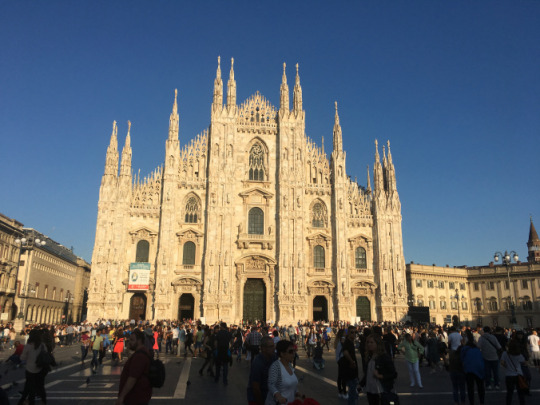
Duomo II Cathedral

View of the Square from the Duomo Terrace
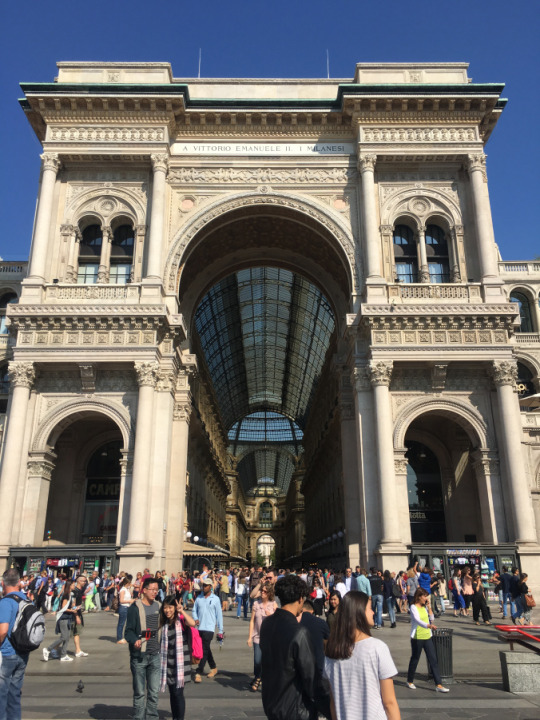
The Galleria – every luxury shopper’s dream
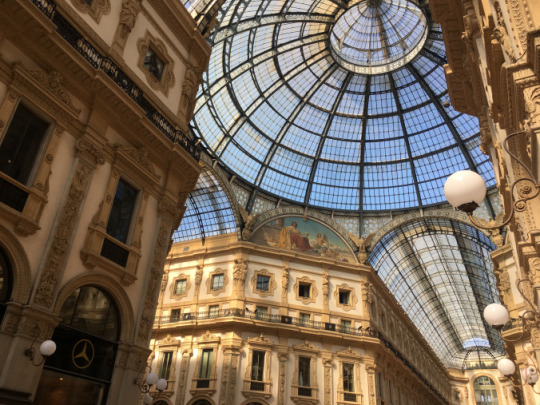
Inside peak of the Galleria
Day 2 – (25 sep 2016): Lake Como + Milan
We had pre-booked a Lake Como tour. The tour included guided boat tour on Lake Como, Milan to Lake Como and back transport by air-conditioned coach and 2 hour transit for personal roaming in Bellagio. I strongly recommend the tour.
Lake Como Tour pics
Lake Como Tour pics
Lake Como Tour pics
Lake Como Tour pics
Lake Como Tour pics
Lake Como Tour pics
In Como Town
Bellagio Port
Lake Como Tour – Bellagio
Narrow Streets in Bellagio
Narrow Streets in Bellagio
Narrow Streets in Bellagio
Narrow Streets in Bellagio
Back in Milan, we headed to the San Lorenzo square and then to Navigli district for drinks and dinner. Lots of trendy bars and restaurants are located. We observed an interesting tradition here. At our pub, we ordered 2 cocktails and was surprised with lots of FREE snacks. So, we ended up skipping dinner.
Free food with cocktails in Navigli District
Navigli District
Day 3- (26 Sep 2016): Manarola
We take train Italia to reach Manarola. There is no direct train. Our stop was at La Spezia and from there we took a train to Manarola. Our hotel Ca’ de Baran was a 2 min walk from the station and 1 minute walk from the Mediterranean sea.The shore had a rocks enclosing a part where you can take a dip.

Take a train to Manarola from La Spezia

Our Den in Manarola
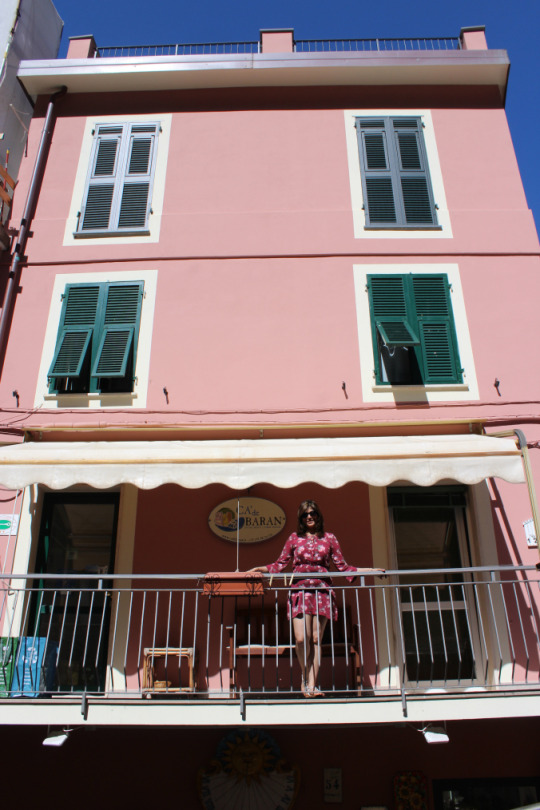
Hotel Ca’ de Baran
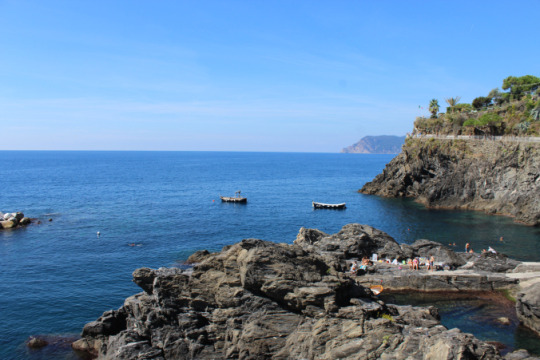
Manarola

Manarola
In the evening we headed out to Rio Maggiore, next train stop. You can either take the train or you can hike.
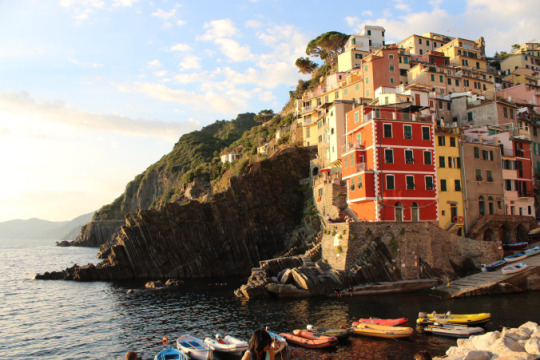
Rio Maggiore
In the evening, try to be back in Manarola by 7 pm and reserve yourself a table by the cliff in Ristorante Nessun Dorma to watch the sunset and also how the colourful houses by the cliff turns into a magical string of lights.

By the night, once you are out of this restaurant compulsorily sit in the dark for hours to enjoy the starry night while listening to the musical by the rocks and the sea, sipping your take away aperol spritz. You can also see Monterosso and Vernazza from this point. This is a safe place.
Must visit restaurants in Manarola are:
For seafood (dinner): Ristorante Marina Piccolo
For best view + cocktails in the evening: Nessun Dorma
Day 4- (27 Sep 2016): Corniglia – Vernazza- Monterosso Trek
10.9 kms. 5.5 hours. 135 floors climbed. (Source: iphone health app)
The track is called the ‘Blue Trail’ or Sentiero Azzurro, which follows the coast. This path starts from Corniglia, so we had to reach the place by Train to the city and then almost climbed at least 25 floors to reach the Blue path gate. You have to 7 Euro per person for one way. Do not lose the ticket because you need to show this at each check point. Though for most of us this sounds scary, but you must go for it. It is worthy. The 5.5 hours includes half an hour break in a quaint restaurant on the cliffs of Vernazza.
Please know that you can start from either direction (Monterosso, heading south, or Corniglia, heading north).
Tip: Start from Riomaggiore, where the paths are easier and paved, and work your way up to the more challenging trails which is closer to Monterosso. So, while you are closer to the north side you are climbing down the high step and not climbing up.
From Corniglia to Vernazza,this trail climbs up to the highest point of the Cinque Terre (and back down) so expect a fair amount of climbing and descending.
Must have essentials for the trek
Wear trekking shoes/ comfortable sneaker
Carry one and a half litres of water for one person (Hydration is extremely crucial)
Carry food and candies (Sugar rush always helps)
Sunscreen
Sun glasses
Hand towel
Since the recommended months for this hike are April, May, September and October, we were lucky to have survived the tolerable heat.
Corniglia- Our starting point
Steep slope entry point
Still smiling…
As we enter the Blue Trail
While you walk keep looking west
Some shade is always welcome
Still miles to go
Interesting format for sharing information
as we cross Vernazza
Still on the Blue Trail
And we see a resting place
Do rest when ever possible to avoid fatigue
and we can see the Monte Rosso Beach
Reach – Moment of glory!
Once you reach the Monterosso chill in the first beach on your path. This is the free beach. Plus, it is quieter to doze off for 30 minutes with the warm pebbles/sand to take care of your body ache. You can also catch lunch and chilled beer for dozing off, like we did.
Stone Therapy
Stone Therapy
In the night we enjoyed a live performance at a joint, where the most of the locals come to chill after a hectic day. Click here to watch the video.
So much, and we are still discussing day 4.
Day 5- (28 Sep 2016)- Naples
We reach our BNB apartment in Naples by 9 pm, and we head out to eat the best pizza of our life. You must remember the name of the place when you visit Naples, it is Gino Toto Sorbillo Pizzeria.
Spiciest Pizza in the house
Naples
Naples – The City scape
Gabrinus, Naples- The President eats breakfast every New Year
Day 6- (29 Sep 2016) – Naples – Pompeii – Sorrento
You can either take a cab/train/bus to Pompeii. After our breakfast in an iconic breakfast joint Naples, Gambrinus, we took the train as it is the fastest during peak traffic hours. Pompeii can be reached by train on Circumvesuviana. On the Naples – Sorrento line, use the Pompei Scavi-Villa dei Misteri stop.
It will not be reasonable to describe the The ‘Pompeii’ experience in this post, so I will soon be dedicating a detailed post on how to cover the ruins in 4 hours. If you are interested do keep visiting my blog.
Pompeii
Pompeii
Pompeii
Pompeii
Pompeii
After reaching our BnB den, we went out for dinner and selected a beautiful garden Ristorante – Parruchiano Favorita, where we were delighted by the warm service by our attendant – Mr. G.
Day 7- (30 Sep 2016)- Island of Capri: Capri town and Anacapri town
I have already written a post our tour. Read here. It definitely was the most highlighted experience of our trip.
In my Capri post I have captured the beauty of nature during our fun boat ride to the isle of Capri. Please keep in mind that most of the island’s sights are located near Anacapri: The Blue Grotto, Villa San Michele and the chairlift for Mount Solaro. Due to paucity of time, we did not visit the Villa as we got lost in the enchanting view of the blue horizon from Mt. Solaro. It felt like heaven. If I recall correctly, I had been magically stunned at similar level in my trip to Cappadocia, Turkey.


Day 8- (1st Oct): Amalfi and Positano
Well, we have come to the last day of our itinerary. Honestly after Cinque Terre and Capri island, these coastal villages did not manage to impress me. Amalfi is very commercialized. The Positano beach was over crowded during our visit. Unfortunately, the day wasn’t a sunny one. Posting a few pics so that you can judge by yourself.
Amalfi Beach
A church in Amalfi town
Positano
Positano
Positano
Next day, we took cab to airport for 80 Euros.
Taxi service contact: Antonio Criscuolo Transfers and Excursions,
+39 333 2656737, [email protected]
Euro Trip in 5 working days – Milan-Cinque Terre- Naples-Sorrento-Capri-Amalfi-Positano Tired of your hectic busy schedule, the Indian summer heat, city traffic and the unending chatter in your mind?
#amalfi#amalfi coast#anacapri#aperol#beach#bellagio#best travel itinerary#blue grotto#blue trail#ca de baran#capri#cinque terre#Corniglia#Corso di Porta Ticinese#duomo cathedral#europe travel#europe trip#galleria#gambrinus#gino toto sorbillo pizzeria#italia#italy#la spezia#lake como#manarola#milan#monte rosso#mount solaro#Music#naples
0 notes